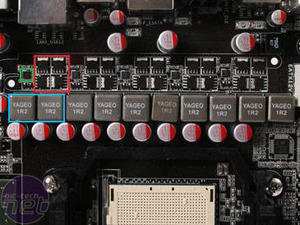Asus M4A79-T Deluxe Features:
- Support for socket 938 AM3 CPUs including Phenom II, and Athlon series.
- AMD 790FX northbrigdge
- AMD SB750 southbridge
- Four 240-pin DDR3 memory slots supporting 1,066 to 1,600MHz DIMMs up to 16GB in total
- Four PCI-Express 2.0 x16 slots (x16/x16 or x8/x8/x8/x8) with ATI CrossFire-X technology support
- Two PCI slots
- Realtek ALC1200 7.1 channel high-definition audio codec, as well as RCA and optical S/PDIF
- One Realtek RTL81112 PCI-Express Gigabit LAN
- Five SATA 3Gbps ports supporting RAID 0, 1, 0+1, 5 and JBOD
- one IDE socket
- one eSATA port
- VIA VT6315N chipset supporting two IEEE1394a Firewire ports (one rear I/O, one pin-out)
- Twelve USB 2.0 ports (six rear I/O, six pin-outs)
Board Layout
The design is typical of Asus - black PCB, copper piping and orange, black, white and blue components. The design still looks good but it's getting a little dated these days in our opinion. The cooling - while adequate and a simple heatpipe - looks very 2006 considering many are now moving to nickel or chrome plated heatpipes for a bit of modern bling. That is, if you care, but once it's in a case many don't think about it again.While the cooling is certainly more than adequate, in our recent Phenom II X3 720 Black Edition overclocking the CPU power phase heatsink got a touch hot, but it was nothing to worry about - the M4A79-T handles elevated voltages very well. The CPU socket has a decent clearance for an AMD socket and the heatsink fins aren't too tall either - but as usual with AMD because the CPU heatsink can only take a single orientation, you'll need to check your memory will fit underneath.
All the ports and connectors are well placed around the board with plenty of finger room, although we would have liked to see all the SATA ports facing 90 degrees outwards. That said, it would be harder for an odd number since we've only got five instead of six. In our opinion, without an extra few SATA ports from an additional controller, Asus is cutting the Deluxe user short as one SATA is cheaply and permanently assigned to eSATA duty.
Onboard power and reset switches are a nice addition, but there's no clear CMOS - that's left to finding and fiddling with a jumper still unfortunately.
One thing that gets us is Asus's "8+2 phase", which is technically 4+1 if we are to go by the company's own definition of a power phase. The 4+1 design is the split between CPU cores and integrated northbridge.
Below you'll see the green, red and blue squares representing the driver IC, MOSFETs and sealed chokes respectively. One driver IC is needed per power phase, so we can see that there are four MOSFETs and two chokes "per phase". Gigabyte has previously used this technique with its "Virtual 12 phase" design - as design which Asus continually lambasted for being "fake 12 phase" in its marketing fluff, but now it seems it's following in the same direction.
Regardless of the laughable politics though, more MOSFETs mean more available power switching and doubling the chokes means a smoother current for a better taste. Fundamentally there's no real need for an extra driver, and we can't argue with that.
In the picture below right also shows the digital switches for converting the two PCI-Express 2.0 x16 lanes into four x8 - the green switching the top two, the red converting the bottom set, with the blue slots being primary and should be filled first. These two have plenty of space between, and even with two dual-slot graphics cards there's still a PCI-Express slot and PCI slot spare. While there are no x1 slots specifically, the x16s are backward compatible to anything from x1 to x16.

MSI MPG Velox 100R Chassis Review
October 14 2021 | 15:04















Want to comment? Please log in.